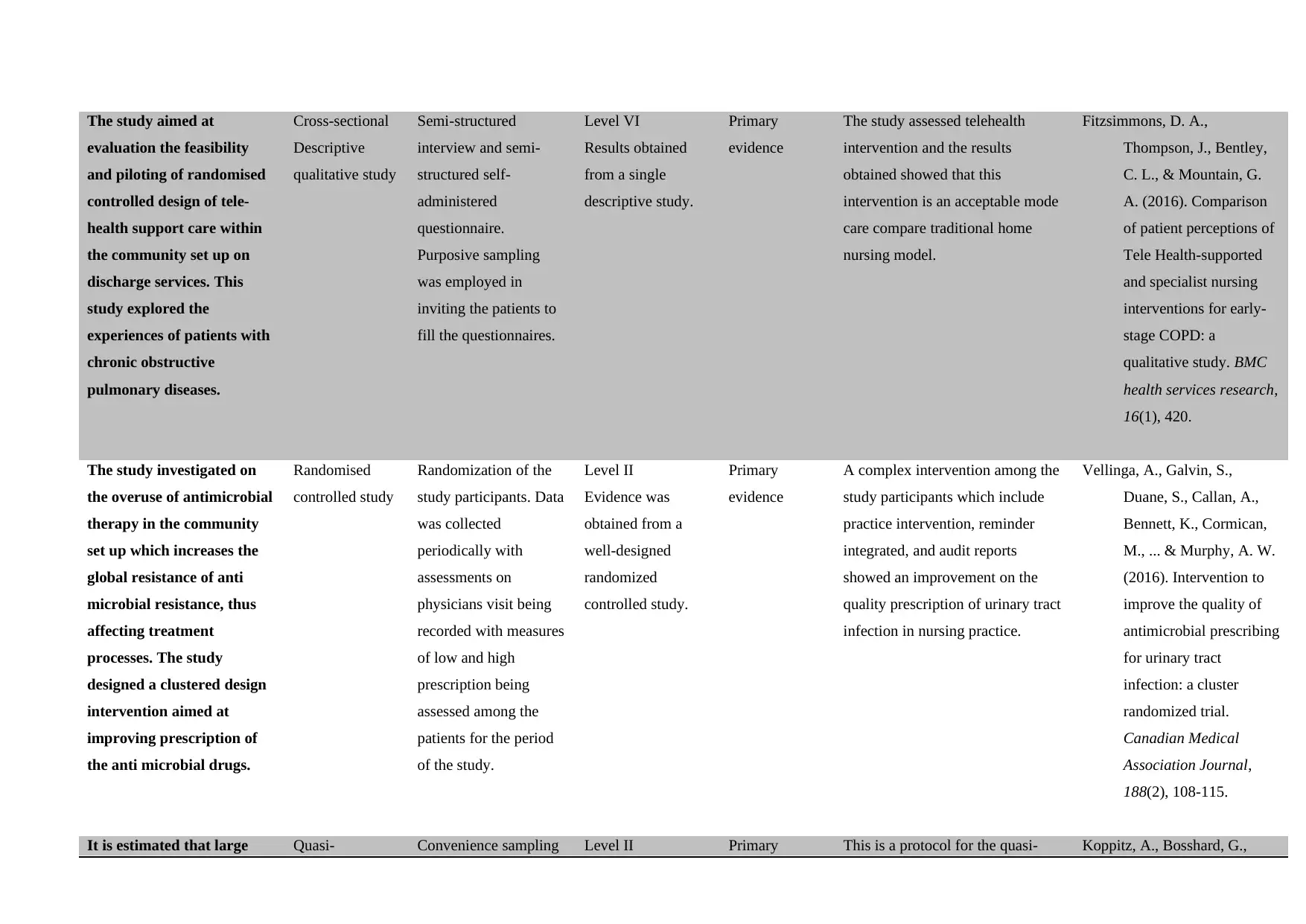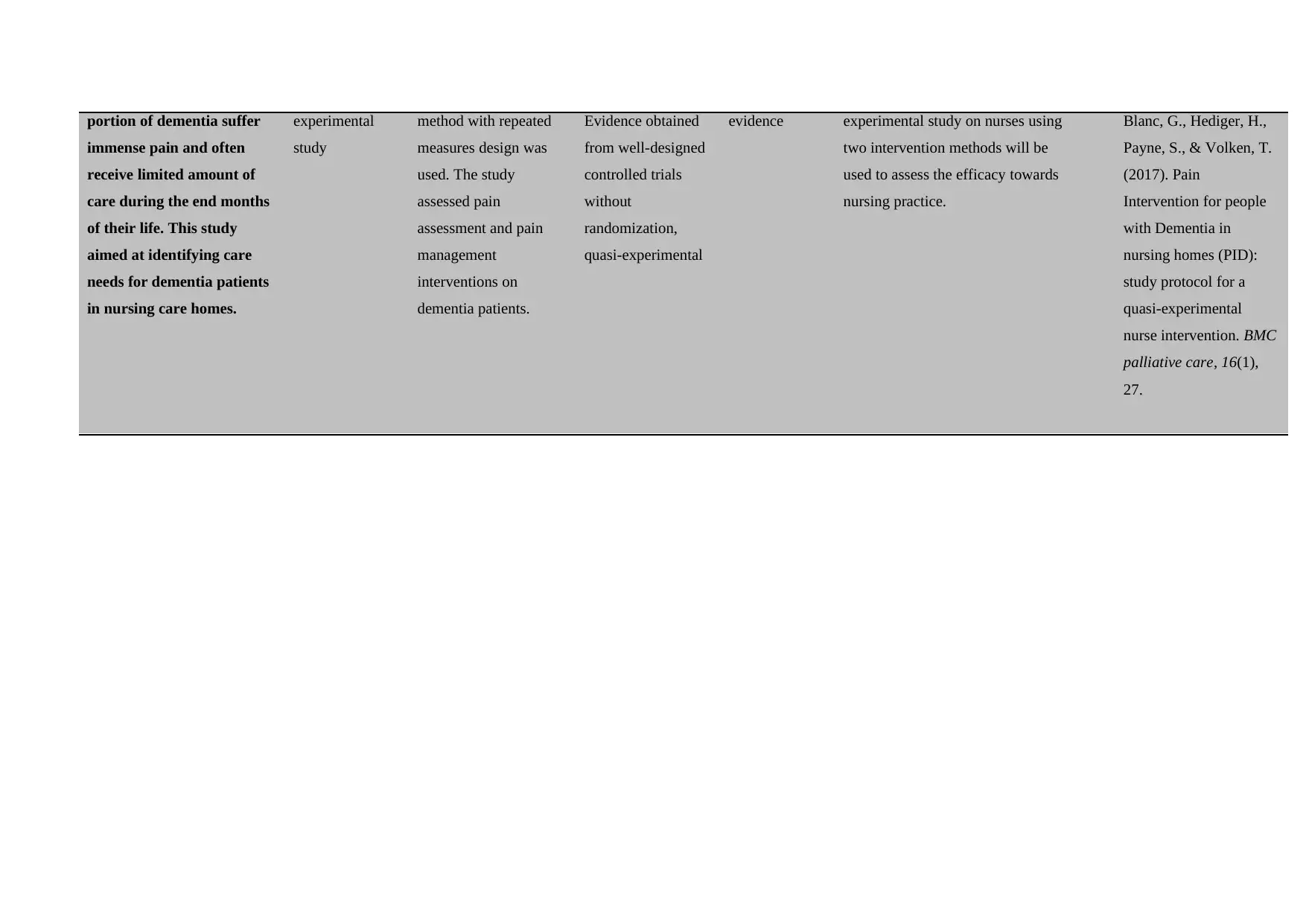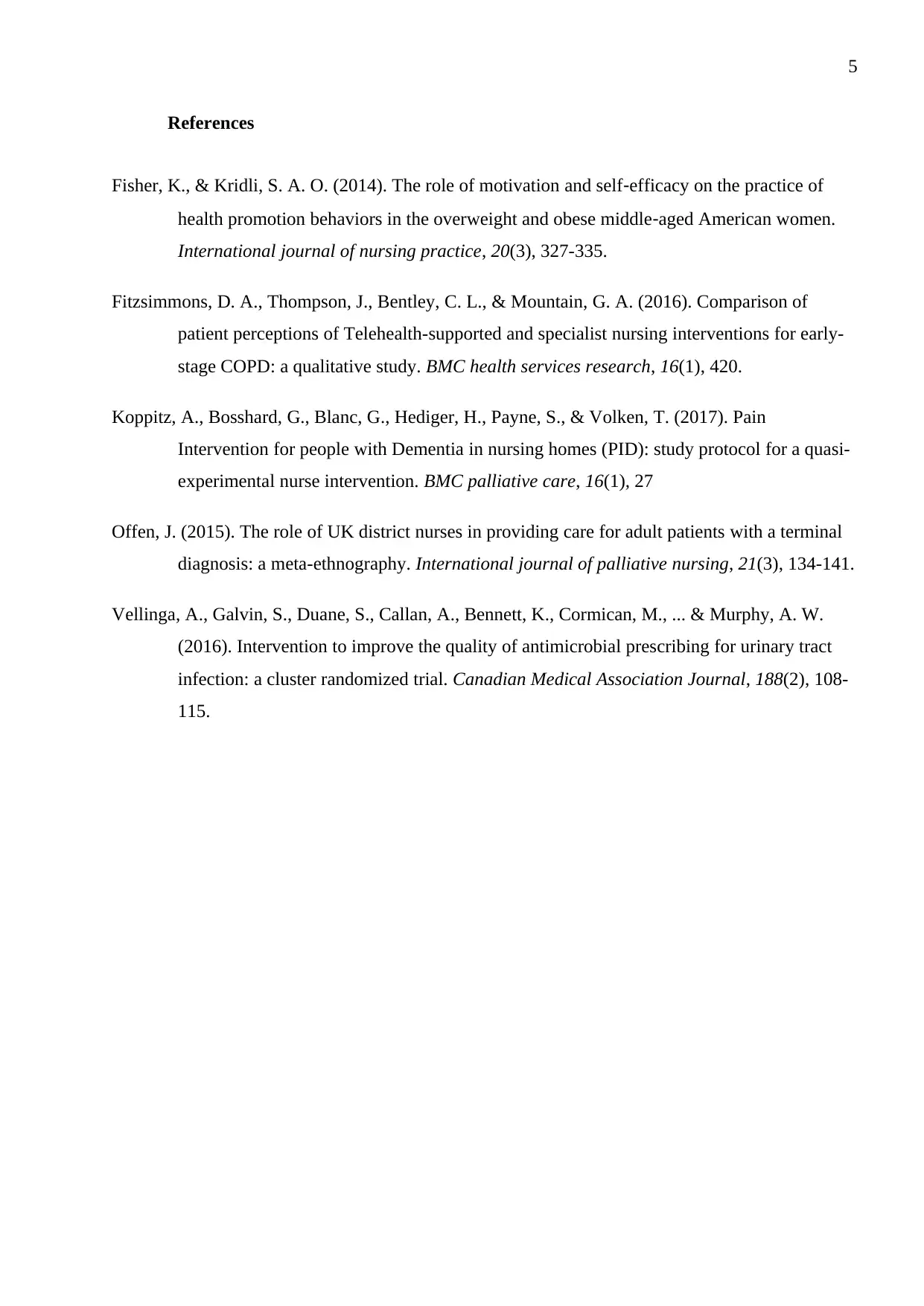Role of UK District Nurses in Palliative Care: A Meta-Ethnography
VerifiedAdded on 2023/06/04
|5
|1115
|494
AI Summary
This study explores the role of UK district nurses in providing care for adult patients with a terminal diagnosis through a meta-ethnography. The study aims to understand the motivators and barriers faced by district nurses in delivering palliative care in community services. The findings reveal five thematic areas of focus which include valuing roles, practical role, patients relationships, and provision of psychological supports.
Contribute Materials
Your contribution can guide someone’s learning journey. Share your
documents today.

1
Clinically Relevant Interprofessional Practice
Kathleen Johnson, RN
NU310M5
Purdue Global University
October 27, 2018
Clinically Relevant Interprofessional Practice
Kathleen Johnson, RN
NU310M5
Purdue Global University
October 27, 2018
Secure Best Marks with AI Grader
Need help grading? Try our AI Grader for instant feedback on your assignments.

2
Title of the study Research
design
Data collection
methods
Level of evidence Primary or
Secondary
Study outcome and relevance to
nursing practice
Reference
The study aimed at
exploring the role of UK
district nurses in the
provision of care for adult
patients which are
experiencing terminal
diseases.
A meta –
Ethnography
analysis
assessment
Studies retrieved from
CINHAL, MEDLINE,
and British Nursing
Index
Level V
Evidence from
systematic reviews
of descriptive and
qualitative studies
Secondary
evidence
The meta-analysis revealed
implications of understanding the
motivators and barriers faced by
district nurses in delivering
palliative care in community
services. The findings revealed five
thematic areas of focus which
include valuing roles, practical
role, patients relationships and
provision of psychological
supports.
Offen, J. (2015). The role of
UK district nurses in
providing care for adult
patients with a terminal
diagnosis: a meta-
ethnography.
International journal of
palliative nursing, 21(3),
134-141.
The study investigated the
role of motivation, self
efficacy and demographic
parameters and its effects
on the health promotion
activities among overweight
or obese middle aged
American women
population.
Quasi
experimental
design
Two groups of women
were treated with two
types of exercises
protocol and assessed
using the two
evaluation tools.
Level III
Evidence obtained
from a controlled
design without
randomization
Primary
evidence
Clinical practice of weight
management needs to focus on the
type of motivation and competence
while assessing for barriers to
behavioural change in nursing
practice
Fisher, K., & Kridli, S. A. O.
(2014). The role of
motivation and self‐
efficacy on the practice
of health promotion
behaviors in the
overweight and obese
middle‐aged American
women. International
journal of nursing
practice, 20(3), 327-335.
Title of the study Research
design
Data collection
methods
Level of evidence Primary or
Secondary
Study outcome and relevance to
nursing practice
Reference
The study aimed at
exploring the role of UK
district nurses in the
provision of care for adult
patients which are
experiencing terminal
diseases.
A meta –
Ethnography
analysis
assessment
Studies retrieved from
CINHAL, MEDLINE,
and British Nursing
Index
Level V
Evidence from
systematic reviews
of descriptive and
qualitative studies
Secondary
evidence
The meta-analysis revealed
implications of understanding the
motivators and barriers faced by
district nurses in delivering
palliative care in community
services. The findings revealed five
thematic areas of focus which
include valuing roles, practical
role, patients relationships and
provision of psychological
supports.
Offen, J. (2015). The role of
UK district nurses in
providing care for adult
patients with a terminal
diagnosis: a meta-
ethnography.
International journal of
palliative nursing, 21(3),
134-141.
The study investigated the
role of motivation, self
efficacy and demographic
parameters and its effects
on the health promotion
activities among overweight
or obese middle aged
American women
population.
Quasi
experimental
design
Two groups of women
were treated with two
types of exercises
protocol and assessed
using the two
evaluation tools.
Level III
Evidence obtained
from a controlled
design without
randomization
Primary
evidence
Clinical practice of weight
management needs to focus on the
type of motivation and competence
while assessing for barriers to
behavioural change in nursing
practice
Fisher, K., & Kridli, S. A. O.
(2014). The role of
motivation and self‐
efficacy on the practice
of health promotion
behaviors in the
overweight and obese
middle‐aged American
women. International
journal of nursing
practice, 20(3), 327-335.

The study aimed at
evaluation the feasibility
and piloting of randomised
controlled design of tele-
health support care within
the community set up on
discharge services. This
study explored the
experiences of patients with
chronic obstructive
pulmonary diseases.
Cross-sectional
Descriptive
qualitative study
Semi-structured
interview and semi-
structured self-
administered
questionnaire.
Purposive sampling
was employed in
inviting the patients to
fill the questionnaires.
Level VI
Results obtained
from a single
descriptive study.
Primary
evidence
The study assessed telehealth
intervention and the results
obtained showed that this
intervention is an acceptable mode
care compare traditional home
nursing model.
Fitzsimmons, D. A.,
Thompson, J., Bentley,
C. L., & Mountain, G.
A. (2016). Comparison
of patient perceptions of
Tele Health-supported
and specialist nursing
interventions for early-
stage COPD: a
qualitative study. BMC
health services research,
16(1), 420.
The study investigated on
the overuse of antimicrobial
therapy in the community
set up which increases the
global resistance of anti
microbial resistance, thus
affecting treatment
processes. The study
designed a clustered design
intervention aimed at
improving prescription of
the anti microbial drugs.
Randomised
controlled study
Randomization of the
study participants. Data
was collected
periodically with
assessments on
physicians visit being
recorded with measures
of low and high
prescription being
assessed among the
patients for the period
of the study.
Level II
Evidence was
obtained from a
well-designed
randomized
controlled study.
Primary
evidence
A complex intervention among the
study participants which include
practice intervention, reminder
integrated, and audit reports
showed an improvement on the
quality prescription of urinary tract
infection in nursing practice.
Vellinga, A., Galvin, S.,
Duane, S., Callan, A.,
Bennett, K., Cormican,
M., ... & Murphy, A. W.
(2016). Intervention to
improve the quality of
antimicrobial prescribing
for urinary tract
infection: a cluster
randomized trial.
Canadian Medical
Association Journal,
188(2), 108-115.
It is estimated that large Quasi- Convenience sampling Level II Primary This is a protocol for the quasi- Koppitz, A., Bosshard, G.,
evaluation the feasibility
and piloting of randomised
controlled design of tele-
health support care within
the community set up on
discharge services. This
study explored the
experiences of patients with
chronic obstructive
pulmonary diseases.
Cross-sectional
Descriptive
qualitative study
Semi-structured
interview and semi-
structured self-
administered
questionnaire.
Purposive sampling
was employed in
inviting the patients to
fill the questionnaires.
Level VI
Results obtained
from a single
descriptive study.
Primary
evidence
The study assessed telehealth
intervention and the results
obtained showed that this
intervention is an acceptable mode
care compare traditional home
nursing model.
Fitzsimmons, D. A.,
Thompson, J., Bentley,
C. L., & Mountain, G.
A. (2016). Comparison
of patient perceptions of
Tele Health-supported
and specialist nursing
interventions for early-
stage COPD: a
qualitative study. BMC
health services research,
16(1), 420.
The study investigated on
the overuse of antimicrobial
therapy in the community
set up which increases the
global resistance of anti
microbial resistance, thus
affecting treatment
processes. The study
designed a clustered design
intervention aimed at
improving prescription of
the anti microbial drugs.
Randomised
controlled study
Randomization of the
study participants. Data
was collected
periodically with
assessments on
physicians visit being
recorded with measures
of low and high
prescription being
assessed among the
patients for the period
of the study.
Level II
Evidence was
obtained from a
well-designed
randomized
controlled study.
Primary
evidence
A complex intervention among the
study participants which include
practice intervention, reminder
integrated, and audit reports
showed an improvement on the
quality prescription of urinary tract
infection in nursing practice.
Vellinga, A., Galvin, S.,
Duane, S., Callan, A.,
Bennett, K., Cormican,
M., ... & Murphy, A. W.
(2016). Intervention to
improve the quality of
antimicrobial prescribing
for urinary tract
infection: a cluster
randomized trial.
Canadian Medical
Association Journal,
188(2), 108-115.
It is estimated that large Quasi- Convenience sampling Level II Primary This is a protocol for the quasi- Koppitz, A., Bosshard, G.,

portion of dementia suffer
immense pain and often
receive limited amount of
care during the end months
of their life. This study
aimed at identifying care
needs for dementia patients
in nursing care homes.
experimental
study
method with repeated
measures design was
used. The study
assessed pain
assessment and pain
management
interventions on
dementia patients.
Evidence obtained
from well-designed
controlled trials
without
randomization,
quasi-experimental
evidence experimental study on nurses using
two intervention methods will be
used to assess the efficacy towards
nursing practice.
Blanc, G., Hediger, H.,
Payne, S., & Volken, T.
(2017). Pain
Intervention for people
with Dementia in
nursing homes (PID):
study protocol for a
quasi-experimental
nurse intervention. BMC
palliative care, 16(1),
27.
immense pain and often
receive limited amount of
care during the end months
of their life. This study
aimed at identifying care
needs for dementia patients
in nursing care homes.
experimental
study
method with repeated
measures design was
used. The study
assessed pain
assessment and pain
management
interventions on
dementia patients.
Evidence obtained
from well-designed
controlled trials
without
randomization,
quasi-experimental
evidence experimental study on nurses using
two intervention methods will be
used to assess the efficacy towards
nursing practice.
Blanc, G., Hediger, H.,
Payne, S., & Volken, T.
(2017). Pain
Intervention for people
with Dementia in
nursing homes (PID):
study protocol for a
quasi-experimental
nurse intervention. BMC
palliative care, 16(1),
27.
Secure Best Marks with AI Grader
Need help grading? Try our AI Grader for instant feedback on your assignments.

5
References
Fisher, K., & Kridli, S. A. O. (2014). The role of motivation and self‐efficacy on the practice of
health promotion behaviors in the overweight and obese middle‐aged American women.
International journal of nursing practice, 20(3), 327-335.
Fitzsimmons, D. A., Thompson, J., Bentley, C. L., & Mountain, G. A. (2016). Comparison of
patient perceptions of Telehealth-supported and specialist nursing interventions for early-
stage COPD: a qualitative study. BMC health services research, 16(1), 420.
Koppitz, A., Bosshard, G., Blanc, G., Hediger, H., Payne, S., & Volken, T. (2017). Pain
Intervention for people with Dementia in nursing homes (PID): study protocol for a quasi-
experimental nurse intervention. BMC palliative care, 16(1), 27
Offen, J. (2015). The role of UK district nurses in providing care for adult patients with a terminal
diagnosis: a meta-ethnography. International journal of palliative nursing, 21(3), 134-141.
Vellinga, A., Galvin, S., Duane, S., Callan, A., Bennett, K., Cormican, M., ... & Murphy, A. W.
(2016). Intervention to improve the quality of antimicrobial prescribing for urinary tract
infection: a cluster randomized trial. Canadian Medical Association Journal, 188(2), 108-
115.
References
Fisher, K., & Kridli, S. A. O. (2014). The role of motivation and self‐efficacy on the practice of
health promotion behaviors in the overweight and obese middle‐aged American women.
International journal of nursing practice, 20(3), 327-335.
Fitzsimmons, D. A., Thompson, J., Bentley, C. L., & Mountain, G. A. (2016). Comparison of
patient perceptions of Telehealth-supported and specialist nursing interventions for early-
stage COPD: a qualitative study. BMC health services research, 16(1), 420.
Koppitz, A., Bosshard, G., Blanc, G., Hediger, H., Payne, S., & Volken, T. (2017). Pain
Intervention for people with Dementia in nursing homes (PID): study protocol for a quasi-
experimental nurse intervention. BMC palliative care, 16(1), 27
Offen, J. (2015). The role of UK district nurses in providing care for adult patients with a terminal
diagnosis: a meta-ethnography. International journal of palliative nursing, 21(3), 134-141.
Vellinga, A., Galvin, S., Duane, S., Callan, A., Bennett, K., Cormican, M., ... & Murphy, A. W.
(2016). Intervention to improve the quality of antimicrobial prescribing for urinary tract
infection: a cluster randomized trial. Canadian Medical Association Journal, 188(2), 108-
115.
1 out of 5
Related Documents
Your All-in-One AI-Powered Toolkit for Academic Success.
+13062052269
info@desklib.com
Available 24*7 on WhatsApp / Email
![[object Object]](/_next/static/media/star-bottom.7253800d.svg)
Unlock your academic potential
© 2024 | Zucol Services PVT LTD | All rights reserved.





